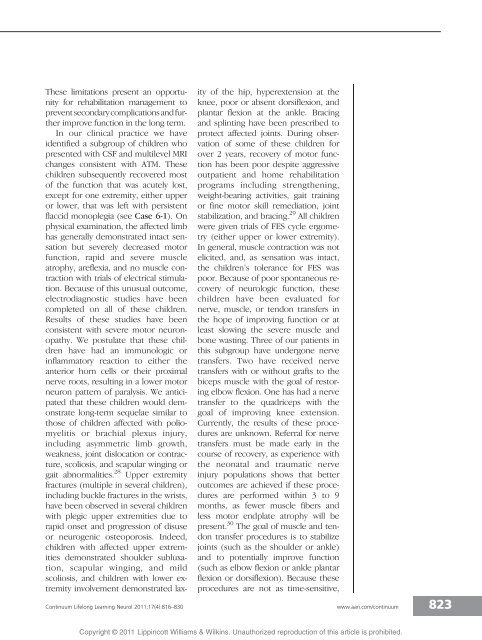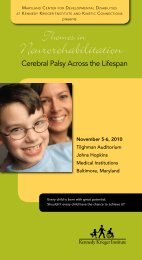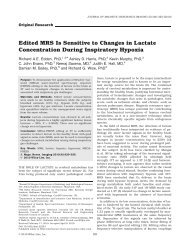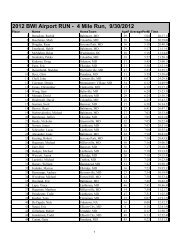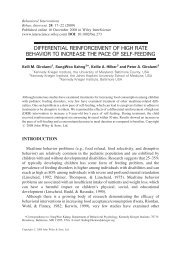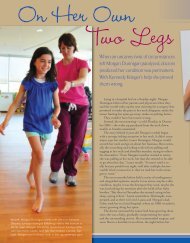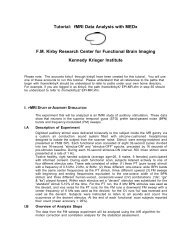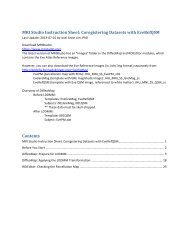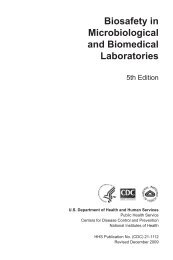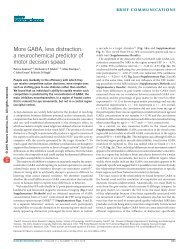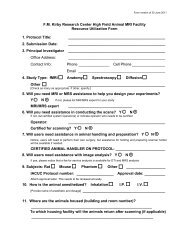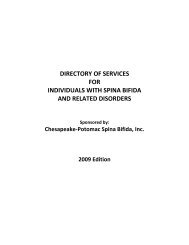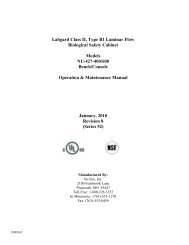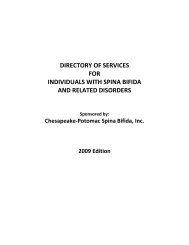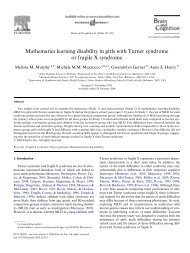Rehabilitation in Transverse Myelitis - Kennedy Krieger Institute
Rehabilitation in Transverse Myelitis - Kennedy Krieger Institute
Rehabilitation in Transverse Myelitis - Kennedy Krieger Institute
You also want an ePaper? Increase the reach of your titles
YUMPU automatically turns print PDFs into web optimized ePapers that Google loves.
These limitations present an opportunity<br />
for rehabilitation management to<br />
preventsecondarycomplicationsandfurther<br />
improve function <strong>in</strong> the long term.<br />
In our cl<strong>in</strong>ical practice we have<br />
identified a subgroup of children who<br />
presented with CSF and multilevel MRI<br />
changes consistent with ATM. These<br />
children subsequently recovered most<br />
of the function that was acutely lost,<br />
except for one extremity, either upper<br />
or lower, that was left with persistent<br />
flaccid monoplegia (see Case 6-1). On<br />
physical exam<strong>in</strong>ation, the affected limb<br />
has generally demonstrated <strong>in</strong>tact sensation<br />
but severely decreased motor<br />
function, rapid and severe muscle<br />
atrophy, areflexia, and no muscle contraction<br />
with trials of electrical stimulation.<br />
Because of this unusual outcome,<br />
electrodiagnostic studies have been<br />
completed on all of these children.<br />
Results of these studies have been<br />
consistent with severe motor neuronopathy.<br />
We postulate that these children<br />
have had an immunologic or<br />
<strong>in</strong>flammatory reaction to either the<br />
anterior horn cells or their proximal<br />
nerve roots, result<strong>in</strong>g <strong>in</strong> a lower motor<br />
neuron pattern of paralysis. We anticipated<br />
that these children would demonstrate<br />
long-term sequelae similar to<br />
those of children affected with poliomyelitis<br />
or brachial plexus <strong>in</strong>jury,<br />
<strong>in</strong>clud<strong>in</strong>g asymmetric limb growth,<br />
weakness, jo<strong>in</strong>t dislocation or contracture,<br />
scoliosis, and scapular w<strong>in</strong>g<strong>in</strong>g or<br />
gait abnormalities. 28 Upper extremity<br />
fractures (multiple <strong>in</strong> several children),<br />
<strong>in</strong>clud<strong>in</strong>g buckle fractures <strong>in</strong> the wrists,<br />
have been observed <strong>in</strong> several children<br />
with plegic upper extremities due to<br />
rapid onset and progression of disuse<br />
or neurogenic osteoporosis. Indeed,<br />
children with affected upper extremities<br />
demonstrated shoulder subluxation,<br />
scapular w<strong>in</strong>g<strong>in</strong>g, and mild<br />
scoliosis, and children with lower extremity<br />
<strong>in</strong>volvement demonstrated lax-<br />
ity of the hip, hyperextension at the<br />
knee, poor or absent dorsiflexion, and<br />
plantar flexion at the ankle. Brac<strong>in</strong>g<br />
and spl<strong>in</strong>t<strong>in</strong>g have been prescribed to<br />
protect affected jo<strong>in</strong>ts. Dur<strong>in</strong>g observation<br />
of some of these children for<br />
over 2 years, recovery of motor function<br />
has been poor despite aggressive<br />
outpatient and home rehabilitation<br />
programs <strong>in</strong>clud<strong>in</strong>g strengthen<strong>in</strong>g,<br />
weight-bear<strong>in</strong>g activities, gait tra<strong>in</strong><strong>in</strong>g<br />
or f<strong>in</strong>e motor skill remediation, jo<strong>in</strong>t<br />
stabilization, and brac<strong>in</strong>g. 29 All children<br />
were given trials of FES cycle ergometry<br />
(either upper or lower extremity).<br />
In general, muscle contraction was not<br />
elicited, and, as sensation was <strong>in</strong>tact,<br />
the children’s tolerance for FES was<br />
poor. Because of poor spontaneous recovery<br />
of neurologic function, these<br />
children have been evaluated for<br />
nerve, muscle, or tendon transfers <strong>in</strong><br />
the hope of improv<strong>in</strong>g function or at<br />
least slow<strong>in</strong>g the severe muscle and<br />
bone wast<strong>in</strong>g. Three of our patients <strong>in</strong><br />
this subgroup have undergone nerve<br />
transfers. Two have received nerve<br />
transfers with or without grafts to the<br />
biceps muscle with the goal of restor<strong>in</strong>g<br />
elbow flexion. One has had a nerve<br />
transfer to the quadriceps with the<br />
goal of improv<strong>in</strong>g knee extension.<br />
Currently, the results of these procedures<br />
are unknown. Referral for nerve<br />
transfers must be made early <strong>in</strong> the<br />
course of recovery, as experience with<br />
the neonatal and traumatic nerve<br />
<strong>in</strong>jury populations shows that better<br />
outcomes are achieved if these procedures<br />
are performed with<strong>in</strong> 3 to 9<br />
months, as fewer muscle fibers and<br />
less motor endplate atrophy will be<br />
present. 30 The goal of muscle and tendon<br />
transfer procedures is to stabilize<br />
jo<strong>in</strong>ts (such as the shoulder or ankle)<br />
and to potentially improve function<br />
(such as elbow flexion or ankle plantar<br />
flexion or dorsiflexion). Because these<br />
procedures are not as time-sensitive,<br />
Cont<strong>in</strong>uum Lifelong Learn<strong>in</strong>g Neurol 2011;17(4):816–830 www.aan.com/cont<strong>in</strong>uum<br />
Copyright @ 201 1<br />
Lipp<strong>in</strong>cott Williams & Wilk<strong>in</strong>s. Unauthorized reproduction of this article is prohibited.<br />
823


